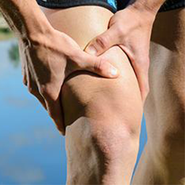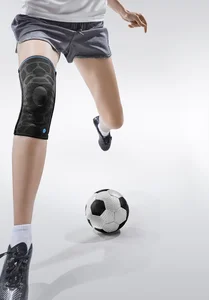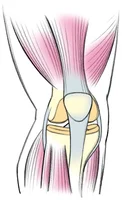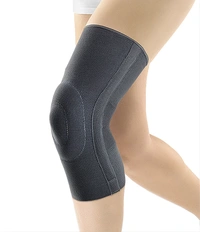Knee Pain
The stretched elastic spring
We jump, run, climb stairs and lift objects every day. These movements are controlled and performed by our knees. Whether you are skiing, hiking up a mountain, playing football or jogging, your knees act like an elastic spring that allows all necessary movements and absorbs shocks.
What are the causes of Knee Pain?
Whenever you bend the knees, stress is placed on the joints. That stress is released when you stretch, jump, start to run and stand up. When you land on the ground, you bend the knees again and the compressed spring acts as a shock absorber. The image of a spring provides a very good idea of the complex interaction of the tendons, muscles and ligaments stabilizing the knee joint. Injuries, wear and tear and inflammation affect this interaction, resulting in pain and discomfort.

Knee pain has several causes. Putting excessive stress on the joint, such as quick turns and moving back and forth when skiing or playing football or tennis, increases the risk of muscle, tendon or ligament injuries. Hyperextending the knee joint can lead to a strain which in the event of a fall can cause bruising. But knee pain can also be the result of bone fractures or a dislocation of the kneecap. A knee overuse injury could also be the reason for pain. The menisci and the ligaments are two important factors contributing to the stability of the knee, which is why they are particularly vulnerable.
What is the Meniscus? What causes pain in the Meniscus?
The menisci are crescent-shaped pieces of cartilage tissue between the thighbone and the tibia that act to disperse the body weight evenly across the joint and absorb friction. The medial meniscus is on the inner side of the joint, whereas the lateral meniscus is on the outside of the knee.
Pain related to the menisci is often caused by the overuse of the knee joint, which in turn is due to twisting motions of the bended knee. In most sports, the knee has to perform and control certain movements, such as sudden turns, twists, starts and coming to a rapid halt, e.g. when skiing. But problems with the meniscus can also be based on prolonged kneeling, for example, when laying tiles. Generally, the medial meniscus is more prone to injury because it is less elastic. As we age, the cartilage tissue in the knee becomes more brittle, hence meniscal tears occur more often.

What is the Cruciate Ligament? And what causes symptoms?
The cruciate ligament and the lateral and medial ligament are the bands stabilizing the knee. The name 'cruciate ligament' derives from the fact that these two ligaments cross each other in the center of the knee.
Excessive force on the knee joint (sudden twists, or abrupt halts or starts), that cannot be absorbed by the muscles may lead to a strain or a tear of the cruciate ligament. These movements are most common when playing football and tennis.
Knee Pain when stretching
Knee pain is frequently linked with certain movements – for example when stretching or extending the leg or the knee, which is the kind of movement you make when climbing the stairs. These specific motion sequences and the accompanying pain are indicative of a damaged knee. A check-up is recommended in case this pain occurs daily when using the stairs.
In general, pain when stretching may have different underlying causes. Three of the most common ones are:
- Damages to the menisci
- Runner's knee
- Patella luxation

Knee Pain when getting up
Symptoms of knee pain include feeling pain when getting up after lying down or sitting for quite some time. Usually, these kinds of aches disappear when moving and the knee might be back to normal after a couple of minutes. In the further course of the disease, the pain will increase and also occur when performing other movements (e.g. climbing stairs).
Tendonitis, which is an inflammation of the tendon connecting the kneecap to the tibia, may also be the cause for knee pain when getting up (known as patellar tendinitis or jumper's knee).
Injuries from overuse of the knee
Injuries of the knee from overuse can occur when jumping and running, for example during a marathon or while playing basketball. The kneecap is surrounded by the patella tendon at the front of the knee joint. Prolonged, excessive strain on the tendon may cause irritation (tendinitis), followed by pains below the kneecap at the tendon insertion. This is called 'runner's knee'. Another rather common overuse injury is called 'chondropathia patellae,' where the back of the kneecap is not sufficiently protected due to a gradual softening of the cartilage tissue in the knee. In this case, extending the joint after squatting or sitting is very painful.
Dislocated knee: Patella Luxation
The kneecap can also slip out of place and then causes significant pain of the knee joint. In general, this kind of injury is called dislocation and is particularly painful in the knee. Patella luxation is the medical term for this trauma.
In most cases, the kneecap jumps back into its groove. However, a subsequent medical examination is highly recommended to exclude any possible damages to the ligaments or the bones. Medical aid is inevitable if the kneecap does not move back on its own and stays dislocated. Even though this is rather uncommon, it does happen. The treatment involves relocating the patella, which should only be done by a doctor because this kind of luxation increases the risk of serious, permanent damage to the knee.
In addition to exercise, congenital and chronic factors can affect the kneecap and increase the dislocation risk. These include:
- Patella dysplasia (congenital deformity or developmental malformation of the kneecap)
- Genu valgum (commonly called knock-knee)
- Patella alta (where the kneecap sits above the groove)
Symptoms of Arthrosis in the knee
This is commonly called joint wear. The cartilage tissue wears slowly off and then may cause pain when moving. This happens after an injury or simply after years of using the knee joint, and it subsequently causes pain when moving. As the disease becomes more advanced, the cartilage tissue may disappear completely and the bones start to rub against one another.




